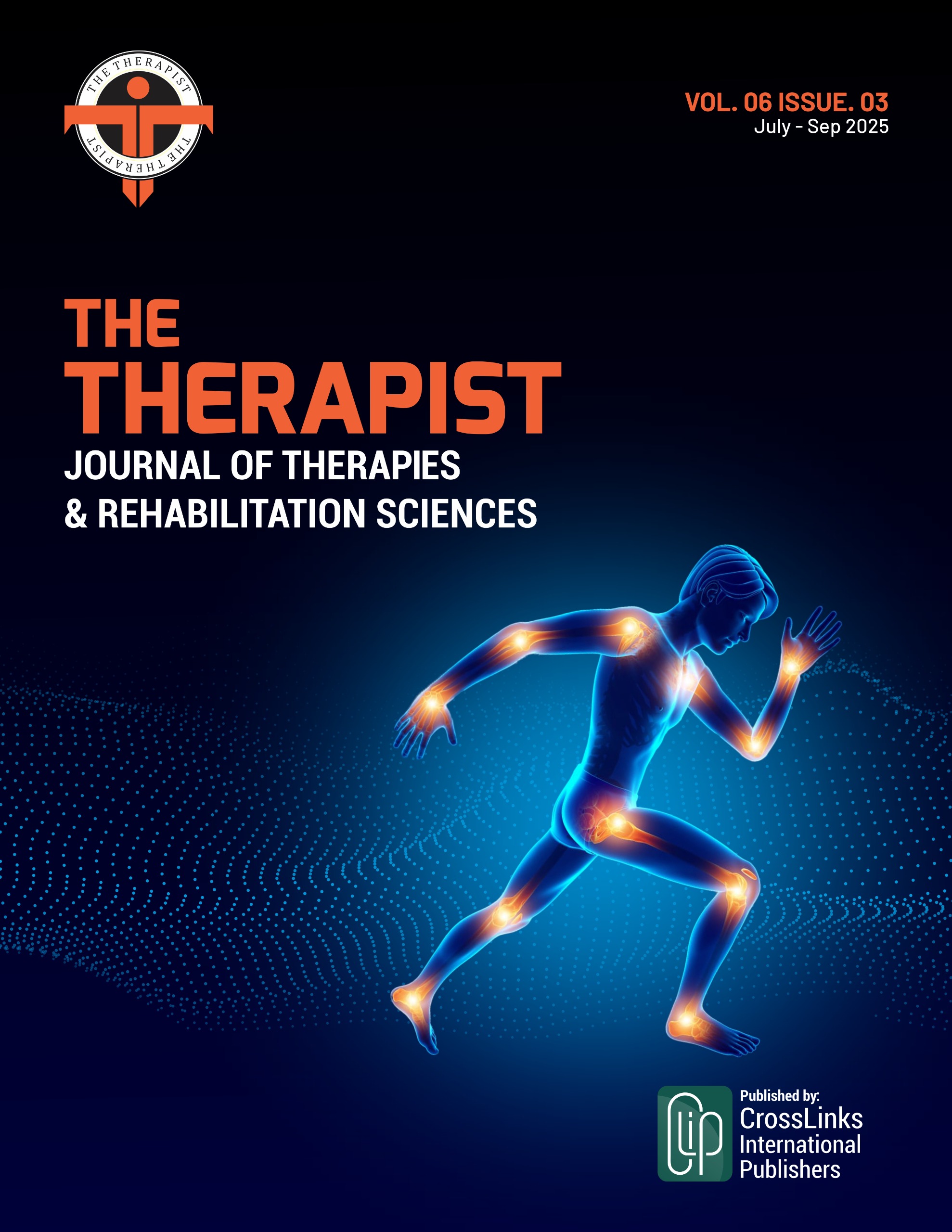Pistoning versus Holding Dry Needling for Pain, Disability, and Cervical ROM in Upper Trapezius Myofascial Pain Syndrome
Pistoning versus Cervical ROM in Upper Trapezius MPS
DOI:
https://doi.org/10.54393/tt.v6i3.283Abstract
Myofascial Pain Syndrome is a prevalent musculoskeletal pain that is characterized by myofascial trigger points. Myofascial trigger points often occur in the upper trapezius. Objectives: To determine the comparison of the effects of the use of pistoning on the pain intensity, the presence of disability, and cervical range of motion in adults with upper trapezius myofascial pain syndrome compared to holding dry needling. Methods: It was a quasi-experimental study in which twenty-four participants were randomized into the pistoning dry needling group (twelve subjects) or the holding dry needling group (twelve subjects). The use of interventions was in three sessions weekly over a three-week continuous period. The outcome measures (prone to pain measured with the help of the Visual Analogue Scale, cervical range of motion assessed with the help of the goniometer, disability measured with the Disabilities of the Arm, Shoulder and Hand questionnaire) were compared at the baseline and one week after the last intervention. Results: The intensity of pain and disability related to the pain was reduced, and the range of motion of the cervix was higher in all directions: flexion, extension, lateral flexion, and rotation. Nonetheless, between-group analysis showed that there were no statistically significant differences in the extent of improvement in any of the outcome measures, which showed that the two techniques were equally effective. Conclusions: Pistoning and holding the dry needling method are effective in pain reduction, cervical range of motion, and disability among upper trapezius myofascial pain syndrome patients.
References
Cao QW, Peng BG, Wang L, Huang YQ, Jia DL, Jiang H et al. Expert consensus on the diagnosis and treatment of myofascial pain syndrome. World Journal of Clinical Cases. 2021 Mar; 9(9): 2077. doi: 10.12998/wjcc.v9.i9.2077.
Jin L and Liu Y. Clinical manifestations, pathogenesis, diagnosis and treatment of peripheral neuropathies in connective tissue diseases: more diverse and frequent in different subtypes than expected. Diagnostics. 2021 Oct; 11(11): 1956. doi: 10.3390/diagnostics11111956.
Lam C, Francio VT, Gustafson K, Carroll M, York A, Chadwick AL. Myofascial pain–A Major Player in Musculoskeletal Pain. Best Practice and Research Clinical Rheumatology. 2024 Mar; 38(1): 101944. doi: 10.1016/j.berh.2024.101944.
Puckett Y, Mallorga-Hernández A, Montaño AM. Epidemiology of mucopolysaccharidoses (MPS) in United States: challenges and opportunities. Orphanet Journal of Rare Diseases. 2021 May; 16(1): 241. doi: 10.1186/s13023-021-01880-8.
Ago Y, Rintz E, Musini KS, Ma Z, Tomatsu S. Molecular Mechanisms in Pathophysiology of Mucopolysaccharidosis and Prospects for Innovative Therapy. International Journal of Molecular Sciences. 2024 Jan; 25(2): 1113. doi: 10.3390/ijms25021113.
Gulati M, Gupta N, Potturi G, Dadia S. Pharmacological and Non-Pharmacological Treatments Available for Myofascial Pain Syndrome–A Scoping Review. Cuestiones de Fisioterapia. 2024 Dec; 53(03): 1656-70.
Saindane RA and Thombre NA. Concurrent use of skeletal muscle relaxants and NSAIDs in low back pain management: A critical review of current evidence and future directions. The Thai Journal of Pharmaceutical Sciences. 2025; 49(2): 5. doi: 10.56808/3027-7922.2997.
Wu X, Wei X, Jiang L, Cai J, Ju M, Zheng X. Is lidocaine patch beneficial for postoperative pain?: a meta-analysis of randomized clinical trials. The Clinical Journal of Pain. 2023 Sep; 39(9): 484-90. doi: 10.1097/AJP.0000000000001135.
Korkmaz MD, Ceylan CM. Effect of Dry-Needling nd Exercise Treatment Oon Myofascial Trigger Point: A Single-Blind Randomized Controlled Trial. Complementary Therapies in Clinical Practice. 2022 May; 47: 101571. doi: 10.1016/j.ctcp.2022.101571.
Alvarez LX, Medina C, Lenfest M, Niebaum K. Physical Modalities. Canine Sports Medicine and Rehabilitation. 2025 Oct: 326-64. doi: 10.1002/9781394251452.ch12.
Lucas K. Effects of latent myofascial trigger points on muscle activation patterns during scapular plane elevation (Doctoral dissertation, RMIT University). 2024.
Galiero R, Caturano A, Vetrano E, Beccia D, Brin C, Alfano M et al. Peripheral Neuropathy in Diabetes Mellitus: Pathogenetic Mechanisms and Diagnostic Options. International Journal of Molecular Sciences. 2023 Feb; 24(4): 3554. doi: 10.3390/ijms24043554.
Baum P, Toyka KV, Blüher M, Kosacka J, Nowicki M. Inflammatory mechanisms in the pathophysiology of diabetic peripheral neuropathy (DN)—new aspects. International Journal of Molecular Sciences. 2021 Oct; 22(19): 10835. doi: 10.3390/ijms221910835.
Bron C, Dommerholt J, Stegenga B, Wensing M, Oostendorp RA. High prevalence of shoulder girdle muscles with myofascial trigger points in patients with shoulder pain. BMC Musculoskeletal Disorders. 2011 Jun; 12(1): 139. doi: 10.1186/1471-2474-12-139.
Sergienko S and Kalichman L. Myofascial origin of shoulder pain: a literature review. Journal of bodywork and movement therapies. 2015 Jan; 19(1): 91-101. doi: 10.1016/j.jbmt.2014.05.004.
Navarro Santana MJ, Sánchez-Infante Gómez-Escalonilla J, Fernández de las Peñas C, Cleland JA, Martín Casas P, Plaza Manzano G. Effectiveness of dry needling for myofascial trigger points associated with neck pain symptoms.
Jimbo S, Atsuta Y, Kobayashi T, Matsuno T. Effects of dry needling at tender points for neck pain (Japanese: katakori): near-infrared spectroscopy for monitoring muscular oxygenation of the trapezius. Journal of Orthopaedic Science. 2008 Mar; 13(2): 101-6. doi: 10.1007/s00776-007-1209-z.
Ay S, Evcik D and Tur BS. Comparison of injection methods in myofascial pain syndrome: a randomized controlled trial. Clinical rheumatology. 2010 Jan; 29(1): 19-23. doi: 10.1007/s10067-009-1307-8.
Cagnie B, Barbe T, De Ridder E, Van Oosterwijck J, Cools A, Danneels L. The influence of dry needling of the trapezius muscle on muscle blood flow and oxygenation. Journal of Manipulative and Physiological Therapeutics. 2012 Nov; 35(9): 685-91. doi: 10.1016/j.jmpt.2012.10.005.
Gerber LH, Shah J, Rosenberger W, Armstrong K, Turo D, Otto P et al. Dry needling alters trigger points in the upper trapezius muscle and reduces pain in subjects with chronic myofascial pain. PM&R. 2015 Jul; 7(7): 711-8. doi: 10.1016/j.pmrj.2015.01.020.
Stathokostas L, Little RM, Vandervoort AA, Paterson DH. Flexibility training and functional ability in older adults: a systematic review. Journal of Aging Research. 2012; 2012(1): 306818. doi: 10.1155/2012/306818.
Aksan Sadikoglu B, Analay Akbaba Y, Taskiran H. Effects of ischemic compression and instrument-assisted soft tissue mobilization techniques in trigger point therapy in patients with rotator cuff pathology: randomized controlled study. Somatosensory & Motor Research. 2022 Jan; 39(1): 70-80. doi: 10.1080/08990220.2021.2005015.
Downloads
Published
How to Cite
Issue
Section
License
Copyright (c) 2025 THE THERAPIST (Journal of Therapies & Rehabilitation Sciences)

This work is licensed under a Creative Commons Attribution 4.0 International License.
This is an open-access journal and all the published articles / items are distributed under the terms of the Creative Commons Attribution License, which permits unrestricted use, distribution, and reproduction in any medium, provided the original author and source are credited. For comments editor@thetherapist.com.pk










